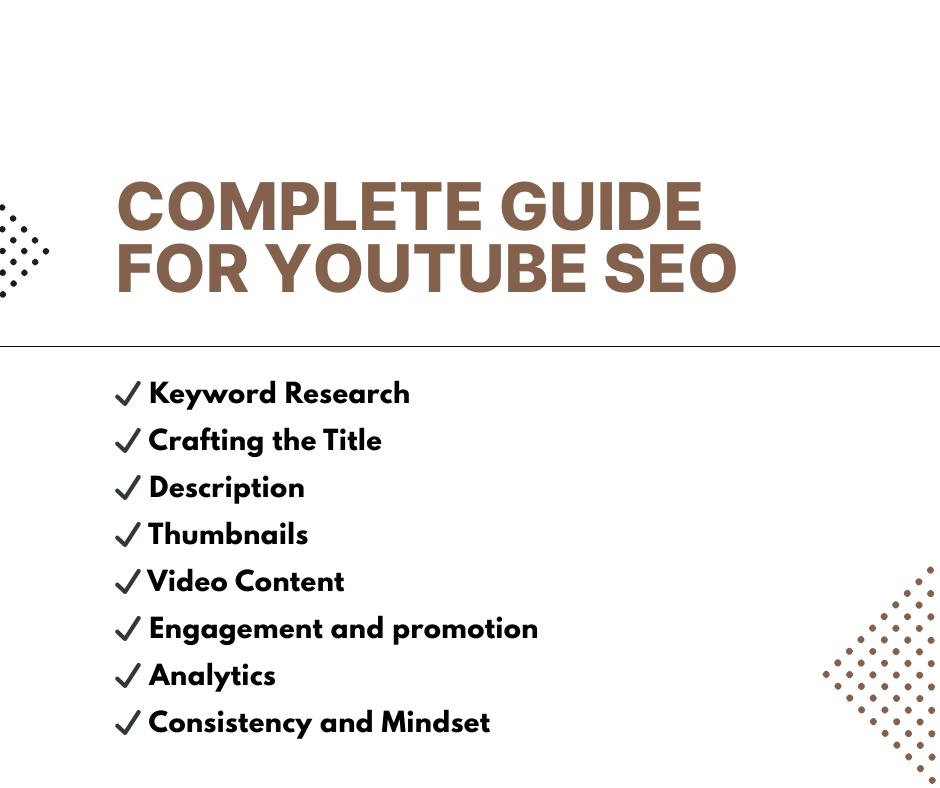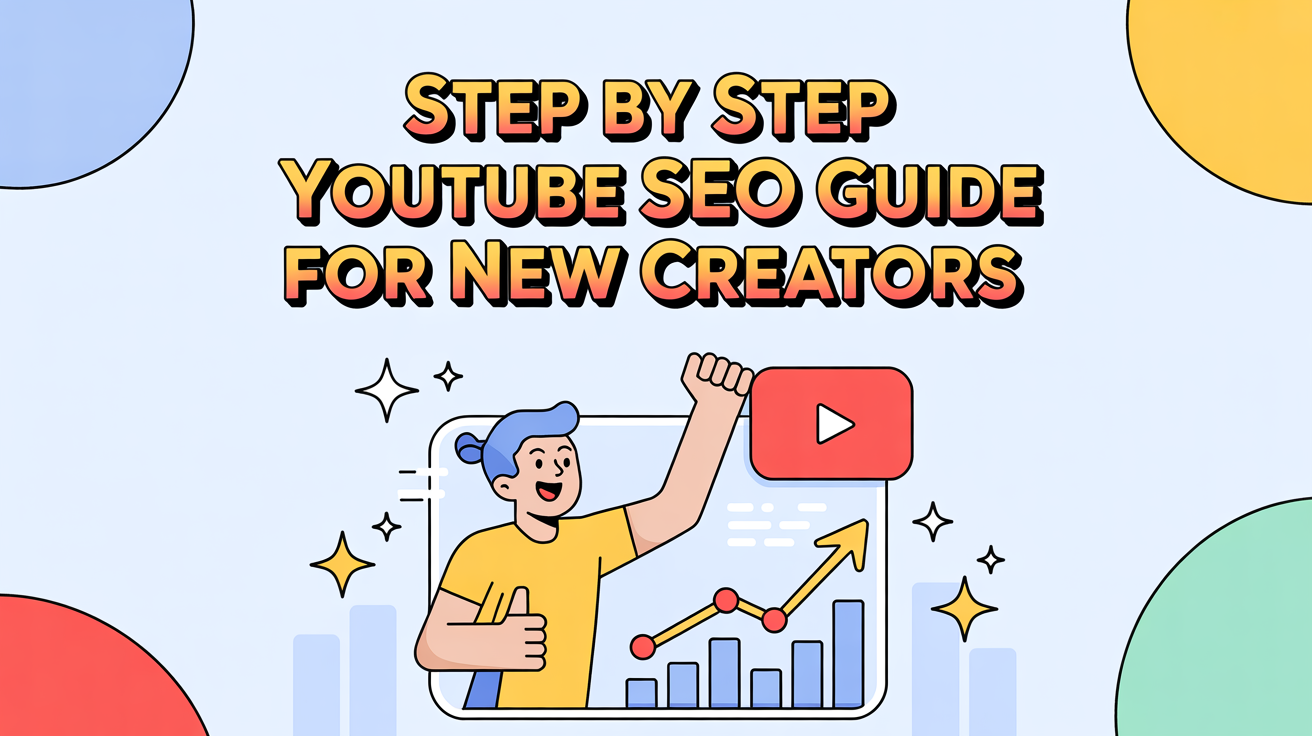You stayed up all night to make a great video, it is all about your hard work, your smile, your sweat every day and night. Now that video has been uploaded on YouTube, but two days have passed and the views are only 37! It breaks your heart, right? You think, “There must be some way to reach people!” That way is – YouTube SEO. And today, I will explain this method to you in such a simple way
what is youtube seo
The full form of SEO is Search Engine Optimization. YouTube itself is a search engine – the second largest in the world. When a viewer types “How to make instant samosa”, YouTube instantly finds videos that:
- match that keyword,
- People should like it (more watch time),
- It should be from a channel that is trusted.
Complete Guide For YouTube SEO

Keyword Research In 2025
Starting with brainstorming
Pick up your mobile, open the Notes app. Now just think: what topic is your channel on? – Cooking, Tech Review, Comedy, Daily Vlog? Then write 15-20 basic words. Example for cooking channel: “Sandwich”, “Chinese”, “Dal Chawal”, “Healthy Breakfast”
YouTube auto-suggest
Now keep typing these words in the YouTube search bar, but don’t write them in full. YouTube will automatically tell you “sandwich recipes in 5 minutes”, “Chinese noodles without onions” etc. People really search for these. Put them in an Excel sheet.
Google Keyword Planner And Google Trends
Keyword Planner (free inside Google Ads) will tell you what the “monthly searches” are. Google Trends will tell you the ups and downs of the topic. If “mango cheesecake” is trending every year in March-June, you know when to make the video.
TubeBuddy / VidIQ
Install TubeBuddy or VidIQ add-on in Chrome. As soon as you open the video, it will appear in the sidebar:
- Overall score (out of 100)
- Search volume vs Competition
- Related long-tail keywords
Secret: Keywords with a score of 40-60 are the “sweet spot” – there is search, but not much competition.
LSI Keywords
If the main keyword is “easy mango ice cream”, then the LSI would be: “no churn”, “3 ingredients”, “summer dessert”, “kulfi style”. Sprinkle these in the title, description and tags, so that the algorithm understands that the video covers the entire “theme”.
A short research routine (30 minutes)
- 10 minutes – Make your brainstorming list
- 10 min – Pick 25 phrases from YouTube auto-suggest
- 5 minutes – Check TubeBuddy score
- 5 minutes – Seasonal check from Google Trends
Repeat this routine once every week – you will always get fresh keywords.
What The September 2025 Google Core Update Means For Your Site :- Read More
Crafting the Title
Psychology
The user decides in 0.7 seconds – whether to click or not. Title + thumbnail together press the “emotional trigger”. Hunger, curiosity, fear, benefit – these four emotions are the strongest. Example:
- Hunger: “Make a quick pizza at home with just 3 ingredients”
- Curiosity: “You will be surprised to see these noodles made from pond water!”
- Benefits: “1 Inch Biceps in 7 Days – No Gym, No Diet”
Keyword Placement
- Main keyword in the first 50 characters – YouTube cuts off long titles on mobile.
- Brackets Trick: “[Live Demo]”, “[Hindi]”, “[No Oven]” – short words, but increase CTR.
- The magic of numbers: “5 Ways”, “3 Ingredients”, “₹20 Budget” – specific numbers build trust.
A/B Testing
TubeBuddy has an AB Testing feature. Run two titles/thumbnails of the same video and see which one gives more CTR in 7 days. Keep the winning version permanent.
Description
First 2 lines – hook + keyword
Only the first 120 characters are visible in YouTube search results and social shares. Example:
“In this video you will learn how to make restaurant-style butter chicken at home with just 5 ingredients. No oven? No problem!”
Here “butter chicken at home” is the main keyword, and “no oven” is the LSI.
Body – time-stamp + links
- 0:00 – Intro & Ingredients list
- 1:45 – Marination secret tip
- 4:20 – Gravy base recipe
- 7:10 – Plating & garnish tips
Search engines also index these time-stamps. Sometimes the user jumps straight to 4:20, but the watch time increases – the algorithm is happy!
Hashtags
The first 3 hashtags matter the most. #ButterChicken #HomeCooking #EasyRecipes. Don’t put more than 15 – it looks like spam.
Storytelling
2-3 line personal touch in description: “My grandma used to tell me when I was little…”, “I tried this recipe during my hostel induction” – viewers connect emotionally and share their stories in comments, increasing engagement.
Thumbnails
Technical Specs
- Resolution: 1280×720 (16:9)
- Size: <2 MB (larger file rejects users with slow internet)
- Format: PNG (clear text), JPG will also work.
Color Psychology
- Red & Yellow – hunger, urgency (eating channels)
- Blue & White – trust, calm (tech review)
- Contrast: The font color should contrast with the background. Increase “Adjust > Contrast” in Canva to 20-30%.
Impact of Face
Our brain reacts instantly when we see human faces. Big eyes, raised eyebrows – surprise; smile – happiness; tongue out – yum! Do not hide more than 10% of your face.
Text Rule
3-4 words, bold font (Bebas Neue, Anton). Not less than 40 pt on mobile. No 2 messages in the same thumbnail – clutter drops CTR.
Branding
Have a small logo or the same font style in every thumbnail. When someone scrolls after 6 months, instantly recognize “Hey, this is our channel!”
Video Content
Hook
Viewers decide in 3 seconds whether to stop or not. Three ways:
- Question Hook: “Do you know how to make pizza without oven in 5 minutes?”
- Visual Hook: Close-up shot of the pizza steaming on the plate.
- Promise Hook: “After this video, you’ll never have to eat take-out pizza again.”
Retention Tricks
- Pattern Interrupt every 30-40 seconds: zoom-in, meme, sound effect.
- Open Loop: “At the end I add a secret ingredient that makes the crust crispy, wait for it!”
- Chapters: Look at the audience retention graph – where there is a drop, add a chapter or jump-cut to the next video.
Video Length
New channel: 6-8 minutes is safe. When avg watch time is 50%+, then try 10-12 minutes. The YouTube myth “longer videos = more money” is completely wrong; rather good retention is the basis of monetization.
CTA Placement
- Early CTA (1 min): “If you like it so far, give it a like!”
- Mid-roll CTA (4-5 minutes): “Comment and tell us what thing you would try?”
- End Screen (last 20 seconds): 1 related video + subscribe circle. Don’t give too many choices – decision fatigue occurs.
Engagement and promotion
Comment Segment
Make sure to ask 1 “interaction question” in every video. “What is your favorite mango dish? Write it down, I will reply to everyone.” The more replies in the first 2 hours, the more signals to the algorithm that “this video is active.”
Playlist Jugaad
- Series Playlist: “30-Day Beginner Yoga” – Next video auto-plays, session watch time increases.
- Keyworded Playlist Title: “Easy Indian Breakfast Recipes” – The playlist itself can also rank in search.
Leverage social media
- Instagram Reels: 30-sec quick tip + watermarking of YouTube link in bio.
- Twitter Thread: Text version of the recipe in 5 tweets. Video link at the end.
- Facebook Groups: Regular value post + video link (not straight spam, doesn’t annoy moderators).
Collab
If you don’t get a collab with someone with 100k subscribers, start with someone with 1k-2k subscribers. Link both channels in each other’s description, suggest videos on the end screen – audiences overlap.
Analytics
Top 3 Metrices
- CTR (Click-through Rate): Above 5% is considered good. If it is less, change the title/thumbnail.
- Avg View Duration: 50% or more of total video.
- Audience Retention Graph: Where there are drops, improve content or editing.
Advanced Section
- Traffic Source: If “Suggested Videos” is low, then the topic or metadata of your video is not matching with any big video.
- Key Moments for Audience Retention: If there’s a dip at 30 seconds, the intro is too long.
- Subscribers vs Returning Viewers: 70% new viewers? Great, chances of video going viral. 70% returning? Your community is strong, but try new keywords to increase reach.
Negative Metric
The “Dislike Ratio” should not be more than 5%. If it suddenly increases, ask in the comments – “What did you find wrong?” Transparency increases trust.
Consistency and Mindset
Content Calendar
A simple Google Sheet: Columns A – Date, B – Video Topic, C – Keyword, D – Status (Scripting, Filming, Editing, Uploaded). Fill it every Sunday night for 30 minutes for the next week
90-Day Rule
Every new channel should post at least 2 videos a week for 90 days, only then the algorithm starts to “understand” it. Do not lose hope even if the views are low during this period – this is the “data feeding” phase.
Avoid Burnout
- Batch Filming: Shoot 3-4 videos a day, edit over the whole week.
- Template Workflow: Intro, Hook, Steps, CTA – Have a preset sequence.
- Celebrate Milestone: 100 subs, 1k watch hours – Give yourself a small sweet treat, dopamine is important
FAQ
Q1. What is YouTube SEO?
Ans:- All those small and big tasks that bring your video to the top in YouTube search and suggestions
Q2. Is SEO limited to titles and tags only?
Ans :- No! Title, description, thumbnail, watch time, engagement – all together make up SEO.
Q3. What are long-tail keywords?
Ans :- Longer than 3-4 words, specific phrase like “no oven pizza recipe at hostel”.
Q4. Do TubeBuddy and VidIQ work for free?
Ans :- Yes, basic keyword score and tag suggestions are available in the free plans of both.
Q5. What should my CTR be?
Ans :- At least 5-6%; if it is 2-3% then change the title-thumbnail.
Q6. How long should I keep my video?
Ans :- 6-8 minutes is best for new channels; extend it only if retention is 50%+.
Q7 Where do I put hashtags?
Ans :- 3-5 at the end of the description; too many are of no use.
